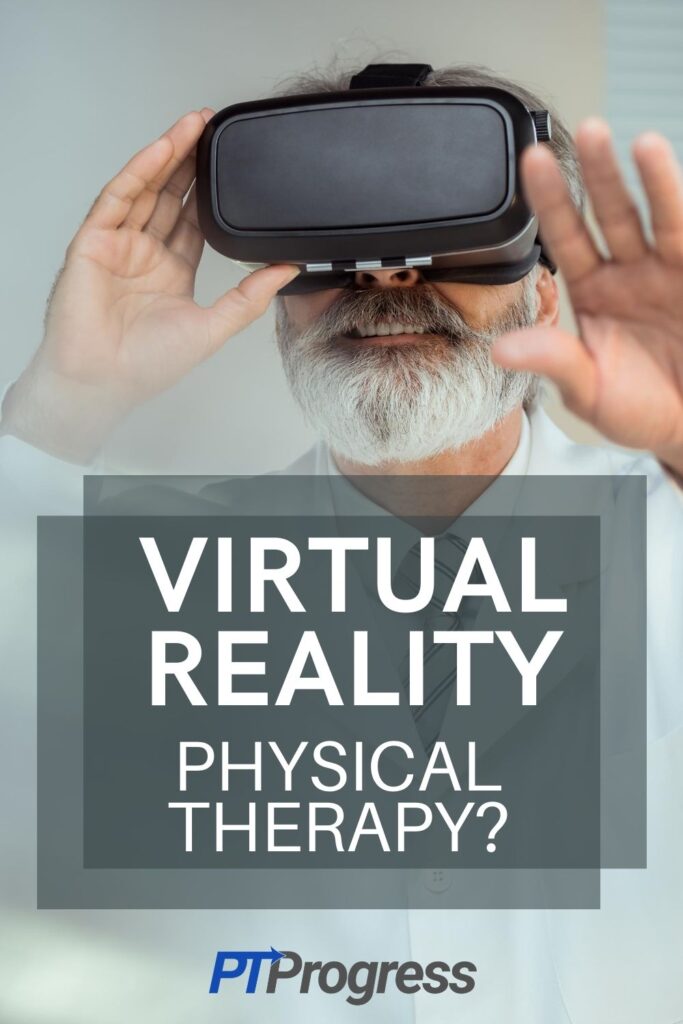
When we hear the words ‘Virtual Reality’, most of us imagine enjoying video games or 3D movies, but this technology goes far beyond just gaming. Virtual Reality (VR) is gaining popularity in healthcare, and especially rehabilitation as a physical therapy treatment modality.1
VR technology started booming and was encouraged to be used for rehabilitation in the early 1990s, even though the technology had already been used in other industries, decades before. The rapid rise in artificial intelligence (AI) led researchers to study a wide variety of different approaches using VR in physical therapy.
Even so, the question still stands, is the hype around this new technology worth it?
This article will explore and answer the question by defining what VR is, how it may influence therapy, the conditions which may benefit from it, and identify some challenges.
What is Virtual Reality?
The Cambridge Dictionary defines VR as “a set of images and sounds, produced by a computer, that seem to represent a place or a situation that a person can take part in” .2
The user can interact with this ‘seemingly real’ environment by receiving sensory feedback, using additional electronic equipment. In simpler terms, VR essentially stimulates an experience that transports the user to another reality.3
How Does Virtual Reality Work in Physical Therapy?
When the user gets consumed in this 3-D environment receiving sensory stimulation, it affects how the brain processes the body and leads to changes in neural activity. Through repetition, VR has the potential of enhancing neuroplasticity and, therefore, new neural connections can be formed and reinforced.
Neuroplasticity is the brain’s ability to change by creating new neural connections, strengthening older ones, and weakening others.4
In physical therapy, VR has a promising impact on neurological rehabilitation and pain management.3 The user will be prompted to perform certain motor tasks while receiving sensory stimulation and feedback, which positively affects neuroplasticity and motor learning.
Which conditions, commonly treated in physical therapy, may also benefit from VR?
Treating Neurological Disorders with Virtual Reality
Disorders affecting the central and peripheral nervous systems such as the brain, spinal cord, peripheral nerves, and other neural structures, are known as neurological disorders.5
These disorders have various different causes and risk factors including genetics, injury/ trauma, infection, tumors, degeneration, or comorbidities due to poor lifestyle habits. Damage to the nervous system may lead to complications affecting movement, coordination, balance, sensation, vision, hearing, cognition, and communication.
Physical therapy typically aims to improve coordination, balance, sensation, and strength, while also aiming to restore normal movement patterns. In order to improve these impairments, therapy incorporates regular repetition of tasks and sub-tasks to improve the neuroplasticity of affected neurons and re-establish the connection between damaged or altered neural structures.
Using VR in rehabilitation is beneficial as it provides more sensory stimulus and feedback when compared to conventional rehabilitation. Research also indicates practicing functional goals and activities in a realistic environment, such as a grocery store, is more effective than practicing it in the ideal circumstances of a clinical setting.6
Common Neurological Disorders Benefiting from VR include:
- Strokes (cerebrovascular accident).
- Alzheimer’s disease and dementia.
- Cerebral Palsy (CP) and developmental delays.
- Brain injuries (TBIs and tumors).
- Parkinson’s disease.
- Multiple Sclerosis (MS).
- Epilepsy.
- Guillain Barre Syndrome (GBS).
One randomized controlled trial (RCT) compared VR rehabilitation to conventional physical therapy in individuals with Parkinson’s Disease. They established that balance and gait were significantly improved among those receiving VR rehabilitation versus conventional therapy.3 Possible reasons for this include;
- More sensory stimulation and feedback is provided.
- Enhanced visual feedback.
- Users are exposed to a variety of different environments.
- Increased confidence and sense of purpose, which is also acquired in real-life activities.
- Increased enthusiasm, motivation, and engagement from the user. This will also increase the likelihood of improved compliance with home-exercise programs.
Studies have recognized similar outcomes for example; improved motor learning, coordination, and functional activities, in conditions such as strokes, CP, MS, Dementia, Brain injuries, and GBS.7,8,9,10,11,12
Treating Chronic Musculoskeletal Disorders with Virtual Reality Technology
Musculoskeletal rehabilitation is another area in physical therapy to benefit from VR technology.
Musculoskeletal disorders are defined as injuries or disorders to the muscles, tendons, ligaments, joints, and discs. These disorders are caused by various different reasons including repetitive stress, trauma/ injury, degeneration, poor posture, and ergonomics, as well as muscle imbalances.
One scoping review of 14 RCTs revealed that VR technology improves motor functioning and joint mobility, as well as significantly relieves pain in individuals with chronic musculoskeletal disorders.13
Possible explanations for this include;
- VR distracts the user from the painful stimuli.
- Improves motor skills through repetition and visual feedback.
- VR programs are often designed to apply cognitive-behavioral therapy (CBT) and therefore improving coping strategies, altering the user’s perception of their pain, and changing their thoughts and emotions associated with the pain.
- VR games are also generally more enjoyable and therefore individuals are generally more compliant with their home-exercise programs.
Common Musculoskeletal Disorders Benefiting from VR include;
- Frozen shoulder
- Shoulder impingement
- Arthritis
- Chronic neck pain
- Chronic low back pain (LBP)
- Pelvic floor dysfunction
Virtual Reality for Acute & Chronic Pain
VR technology is commonly used in healthcare settings to relieve pain.14 This is achieved in acute pain management when the user is distracted from the painful stimuli through the interactive experience, which will reduce the user’s perception of their pain. It’s also beneficial in medical procedures such as wound care, dressing changes in burn-injuries, surgery, and chemotherapy15.
Limited evidence is, however, available examining the impact of VR on chronic pain, but current research suggests the relief in pain could be explained through CBT programs as explained above16.
Is VR Beneficial for Other Conditions?
Other conditions, not commonly treated by physical therapists, which may also benefit from VR technology include mental health disorders17 such as:
- Schizophrenia.
- Depression.
- Anxiety.
- Addiction.
- PTSD.
- Body dysmorphia and eating disorders.
Some Challenges of Virtual Reality in Medicine
When compared to general pharmaceutical analgesia, VR technology has remarkably fewer harmful side effects. However, one review mentioned that extensive use may cause eye-strain, ataxia, and dizziness following therapy19, while some challenges include limited support-staff, therapist knowledge, management support, and funds18.
Bottom Line:
VR technology is progressively growing in more fields such as tourism, space, education, courtrooms, and military training. While the current research provides promising results for physical therapy, the long term impact is not clear yet.
For now, VR rehabilitation might not be a necessity but could be a game-changer for certain individuals with neurological-, musculoskeletal-, and pain – or mental health disorders. It’s suggested that VR technology can be used in adjunct to conventional therapy, but not replace it.
Some of the well-known VR products currently used for rehabilitation include MindMotionPRO from MindMaze, Rewellio on Oculus Quest, Kinect, Kat VR, and ReGame VR.
I’ve personally not used this type of technology in therapy yet, but cannot wait to try it out! If you’re a Physical Therapist and not sure whether you should incorporate it into your practice, find out if you can rent a VR headset in your area or contact a practice that already uses it.

Eugenie is a Physical Therapist from South Africa and graduated from Stellenbosch University in 2018. She has experience working in the public and private health sectors in South Africa and has a special interest in neurological and orthopedic rehabilitation. In her free time, she enjoys reading, Pilates, and spending time outdoors with friends and family.
References
3. Feng H, Li C, Liu J, et al. Virtual Reality Rehabilitation Versus Conventional Physical Therapy for Improving Balance and Gait in Parkinson’s Disease Patients: A Randomized Controlled Trial.
4. Cheung KL, Tunik E, Adamovich SV, Boyd LA. Neuroplasticity and Virtual Reality.
19. Rose T, Nam CS, Chen KB. Immersion of virtual reality for rehabilitation – Review.

